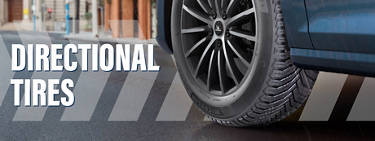While shopping for tires, you may notice that each tire has a different tread pattern. A tire’s tread pattern is key to delivering specific performance, such as braking, cornering, handling and traction.
You probably came across tire descriptions, too, that mentioned different kinds of tread patterns, including directional. What is a directional tread pattern and why is it important? Do you want directional tires? Let us explain!
WHAT ARE DIRECTIONAL TIRES?
There are four common tread designs: symmetrical, asymmetrical, directional and directional & asymmetrical. You can read more about common tire patterns here.
Directional tires have a pattern that is angled to point in one direction. They are also sometimes called “v-shaped” tread patterns.
They offer powerful handling in wet conditions due to the angled tread blocks which push water away from the tire’s contact patch more effectively. You will usually see this tire type on performance vehicles, like sports and muscle cars.
You can’t rotate directional tires from one side of the vehicle to the other without a heavily involved mounting and dismounting process because the tread is designed to rotate in only one direction. So, if you want to rotate your tires (highly recommended to extend your tire’s service life) to a different side instead of front to back, the tires must be dismounted from the wheel entirely and remounted so it faces the other side. For example, if it was facing left (driver’s side), it would need to be remounted facing right (passenger side).
Luckily, directional tires have an arrow on their sidewall to illustrate their correct direction. Improperly mounted directional tires will see reduced performance, including wet traction.
You can also turn to your tire experts at Discount Tire to properly care for and maintain your tires. Many of our services are included with your tire purchase!
MAKE AN APPOINTMENTHOW TO TELL IF TIRES ARE DIRECTIONAL?
Directional tires can be distinguished by their “v” shaped tread pattern.
The tread will look like an arrow and should be pointing toward the front of your vehicle. This effect is caused by the lateral voids and channels (the dips and pathways) which point forward and down. Channels on both sides of the tread will join together, forming a waterfall, “Y” or “V” shape.
Typically, directional tread tires have a solid center rib for added high-speed stability.
You will typically see directional tires mounted on performance vehicles. Older performance cars often had directional tread original equipment tires. OE tires for these types of vehicles now trends more toward asymmetrical tires with higher speed ratings but many still prefer directional treads as replacement tires.
ARE DIRECTIONAL TIRES GOOD?
That depends on what kind of performance you’re looking for.
Directional tires are excellent in wet and high-speed handling. The V-shaped tread channels water away from the tire better than a symmetric tire. The solid center rib adds rigidity, which helps with high-speed control, too. You’ll find they do very well in dry conditions as well due to their maximum road contact design.
Also, directional tires offer better fuel efficiency due to less rolling resistance.
But these aspects come with a price: longevity and cost.
High-performance tires come at higher price points due to the cost of premium rubber compounds and materials, especially compared with standard passenger tires.
Since you can’t easily rotate tires side to side, drivers tend to simply swap out front and back pairs. This reduces the opportunity to fully utilize the tread life on all four tires.
Ready to roll?
Unsure what tire works best for you? Check out Treadwell, our online tire recommendation guide. In less than a minute, we can pair you with the best tires for you, your vehicle and your zip code. Treadwell is backed by rigorous testing, data and customer input!
START WITH TREADWELLIf you have any questions or concerns, please come to us. Safety is our number-one concern and making sure you roll out of our bays safe and satisfied is our ultimate goal.
Good wheel and tire maintenance with regular wheel cleaning is vital to keeping your rims healthy.
Walk-ins are always welcome but we also encourage you to buy and make your appointment online first. Wait less time when you buy and book online!
For more information on this and other tire and wheel services, check out our YouTube Channel or reach out to us on X, Facebook and Instagram.

